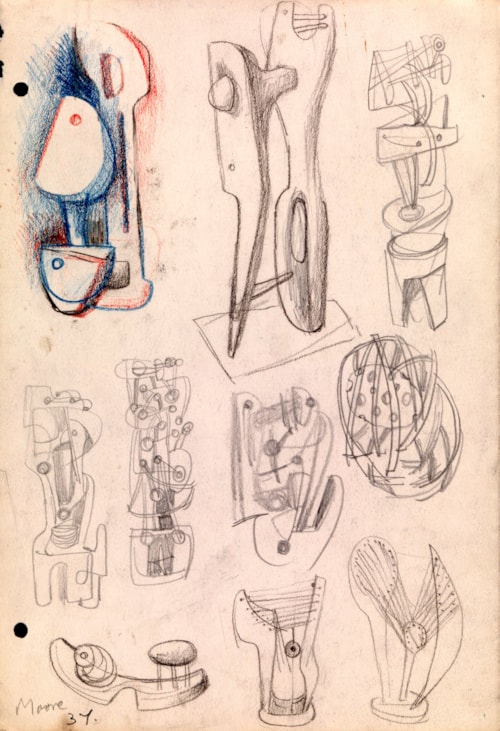
Henry MOORE
Castleford 1898 - Much Hadham 1986
Biography
Drawing was at the centre of Henry Moore’s artistic practice. Over the course of his long career, he made over seven thousand drawings, many of these as part of sketchbooks (though the artist preferred the term ‘notebooks’). Moore’s myriad drawings – studies from life, copies after the work of earlier artists, studies of objects from nature and, most significantly, studies and ideas for sculptures – seem to have always been regarded by the artist, as well as by contemporary scholars and artists, as significant works of art in their own right. They were included in exhibitions of his work from the very start of his career; indeed, his first solo exhibition, at the Warren Gallery in London in 1928, included fifty-one drawings alongside forty-two sculptures. (Several drawings from the exhibition were acquired by the curator and art historian Kenneth Clark – who was to become one of Moore’s most fervent supporters – as well as the artists Jacob Epstein, Henry Lamb and Augustus John.) Moore’s second one-man show, at the Leicester Galleries in 1931, included thirty-four sculptures and nineteen drawings. In later years, a number of gallery and museum exhibitions were devoted solely to Moore’s drawings, the first being held at the Zwemmer Gallery in London in 1935. As further evidence of his desire to have his drawings regarded as autonomous works of art, Moore often unbound his sketchbooks and sold the individual drawings to collectors.
During much of the early part of the Second World War, when commissions were few and materials for stone or wood sculpture hard to come by, Moore poured his energy into drawing. The most significant of these works, and certainly the best known, were the so-called shelter drawings, made in London in the early 1940s. Depicting people taking refuge in London Undergound stations during the nightly bombing of London during the Blitz, they were mostly drawn from memory on the basis of sketches and notes made on the spot. Moore continued to produce these shelter drawings when he left London for the village of Perry Green, near Much Hadham in Hertfordshire, when his home in Hampstead in north London was damaged during the Blitz. The shelter drawings soon came to the attention of Kenneth Clark, by then the Director of the National Gallery, as well as Surveyor of the King’s Pictures and Chairman of the War Artists Advisory Committee. Clark commissioned Moore to create a series of shelter drawings as an official War Artist, and several were exhibited at the National Gallery in London in 1941. They are today regarded as among the artist’s greatest achievements as a draughtsman.
Moore returned to sculpture in 1943, and continued to generate most of his ideas through the practice of drawing. As Andrew Causey has noted, ‘He did not use drawing to resolve parts of sculptures he planned to make: his drawings for sculptures are always of finished objects, and he rarely seems to have worked on sculptures with drawings around him, as if, once he had decided on the result he was looking for, drawing was no longer useful. To that extent drawing and sculpture were separate practices: one began where the other ended.’ In the 1950s, Moore’s growing international success, and the increasing number of commissions he received, led to a considerable decline in the amount of drawings he produced. He began to concentrate on sculpture, using drawings mainly to develop ideas for specific works rather than as a means of experimentation. (He also created designs for sculpture in the form of clay or plaster maquettes.) With the exception of the shelter drawings he produced during the Second World War, however, Moore rarely gave specific or descriptive titles to his drawings, preferring to exhibit them under generic titles such as ‘Drawings for Sculpture’, ‘Drawings for Carving’, ‘Ideas for Sculpture’, and so forth.



